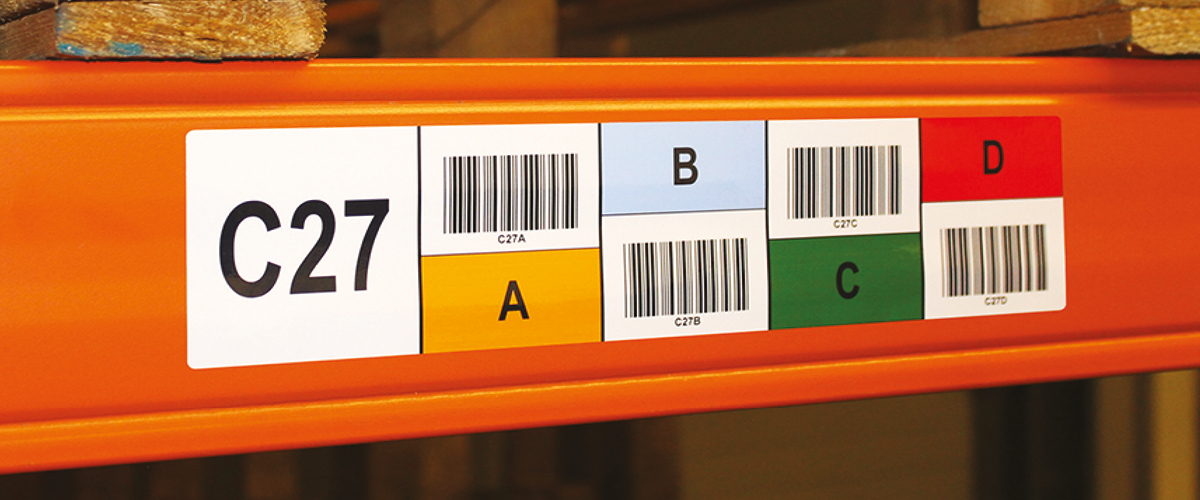Whether you're running a small warehouse or managing a large distribution centre, having an organised and well-labelled warehouse is crucial for streamlined operations. A well-designed and properly implemented labelling system can improve accuracy, efficiency, safety, and customer satisfaction.
So, whether you're just starting out or looking to improve your current system, keep reading this guide to learn about the importance of a warehouse labelling system and how to implement one in your business.
What is a Warehouse Labelling System?
-
Definition of Warehouse Labelling:
A warehouse labelling system refers to the process of labelling and identifying storage locations and products within a warehouse or distribution centre. Warehouse labels can be applied to floors, racks, shelves, bins, and even individual products or pallets to help identify their location and contents.
-
Importance of Having a Warehouse Labelling System:
A well-designed warehouse labelling system is essential for ensuring employees can quickly and easily locate products and materials. This not only increases efficiency and productivity but also reduces the likelihood of errors and accidents that can result from misplacing or mishandling items. Moreover, having an effective warehouse labelling system in place can help businesses optimise their space, reducing clutter and improving organisation.
-
Types of Warehouse Labelling Systems:
There are several types of warehouse labelling systems, including:
Rack Labels
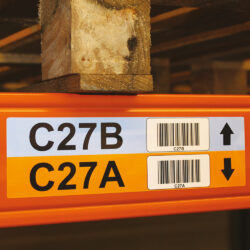
Rack labels are typically used to identify individual shelves or bays within storage racks. The labels are often made of polyester, paper, or vinyl, and are often inserted into label or ticket holders for protection against wear and tear. They attach to racking via magnets or adhesive.
Floor Labels
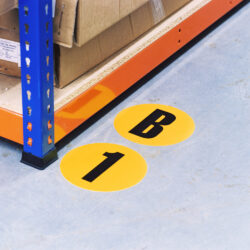
Floor labels are used to mark aisles, walkways, and traffic lanes within the warehouse. These labels are often made of durable materials like vinyl or polyester, and they may feature arrows, numbers, or symbols to help direct traffic.
Aisle and Bay Markers
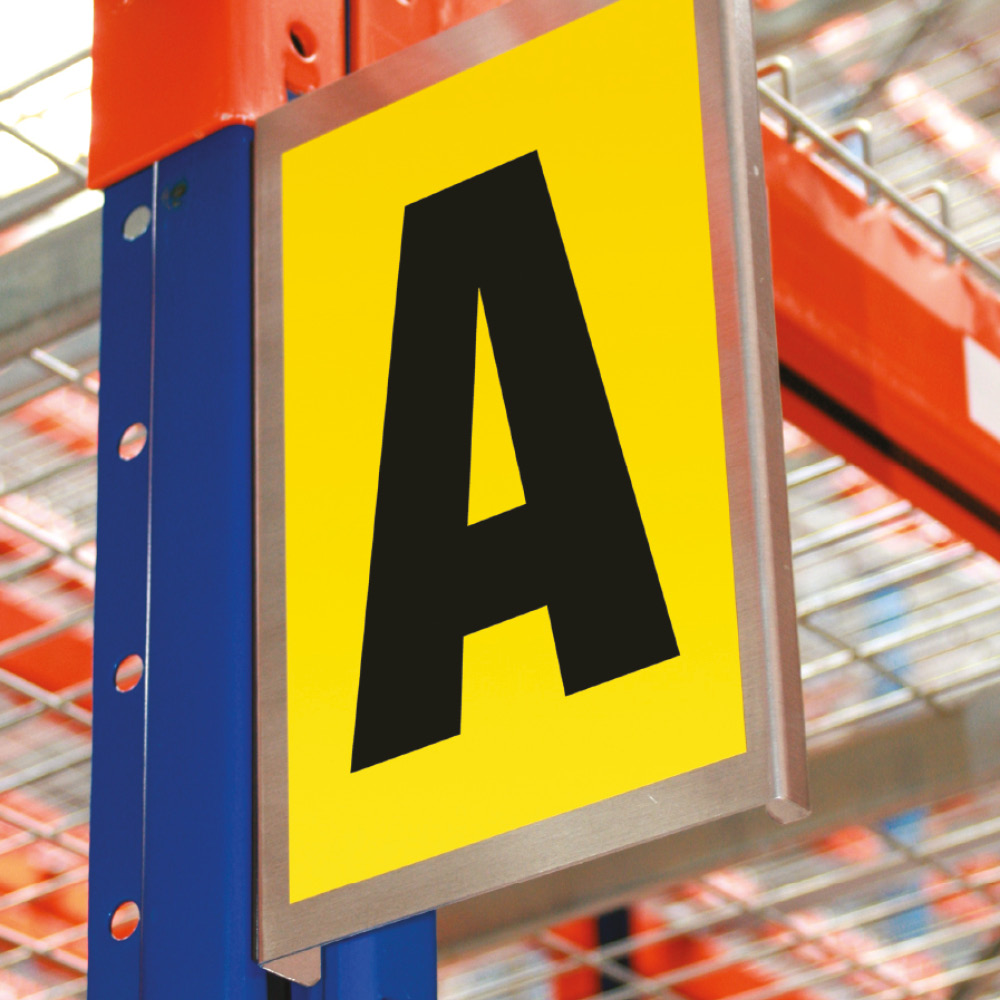
Aisle and bay markers are used to identify entire sections of the warehouse or distribution centre. These labels may be attached to the floor or ceiling and may feature numbers, letters, or colour-coded systems.
Pallet Labels
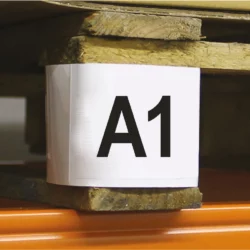
Pallet labels are used to identify individual pallets and their contents. These labels may include information like the product name, SKU, lot number, and expiration date.
No matter what type of warehouse labelling system you choose, the goal is to make it easy for employees to locate products and materials quickly and accurately.
Why Your Business Needs a Warehouse Labelling System
-
Improved Efficiency and Productivity
By implementing a warehouse labelling system, you can reduce the amount of time and effort employees spend searching for products and materials. This not only increases overall efficiency and productivity but also reduces the likelihood of errors and accidents that can result from misplacing or mishandling items.
-
Enhanced Safety
A well-designed warehouse labelling system can also improve safety within the warehouse or distribution centre. By using floor markings, you can outline traffic lanes, walkways, and hazardous areas, which will reduce the risk of accidents and injuries.
-
Better Space Utilisation
A warehouse labelling system can also help businesses optimise their space and reduce clutter. By accurately identifying the location of products and materials, you can avoid unnecessary double-handling and ensure items are stored in the most appropriate location. This not only saves time and effort but also helps with organisation efforts and limits the risk of damage to products.
-
Improved Customer Satisfaction
Finally, a warehouse labelling system can help businesses enhance customer satisfaction by ensuring orders are fulfilled quickly and accurately. By reducing errors and delays, businesses can increase customer loyalty and drive repeat business.
Overall, implementing a warehouse labelling system can have numerous benefits for businesses of all sizes. Whether you're looking to improve efficiency, enhance safety, or optimise your space, a well-designed labelling system can help you to achieve your goals.
Choosing the Right Warehouse Labels for Your Business
-
Consider Your Needs
Before you can choose the right warehouse labels for your business, it's important to consider your specific needs. Ask yourself questions like:
- What type of products or materials do we store?
- How much space do we have available?
- How frequently do we move or rotate inventory?
- What kind of traffic flow do we need to accommodate?
- What level of security is required for our products?
By understanding your needs and goals, you can choose the right labels to meet your requirements.
-
Material and Durability
When choosing warehouse labels, it's important to consider the materials and durability. Labels that will be exposed to harsh environments or frequent handling may require a more durable material such as polyester. Meanwhile, labels for environments which aren’t as demanding may be able to use less expensive materials such as paper or vinyl.
-
Fixing
The fixing method used for your warehouse labels is also an important consideration. Self-adhesive labels are designed to be permanent, while labels with magnetic fixings can be easily removed or repositioned as needs require.
-
Size and Visibility
Labels that are too small may be difficult to read or may not provide enough information, while labels that are too large may take up too much space. Additionally, labels should be placed in a visible location to ensure employees can quickly and easily locate the information they need.
-
Customisation and Branding
Finally, consider whether you need customised labels that include your company logo, branding, or specific product information. Customised labels can help improve brand recognition and make it easier for employees to identify specific products or materials.
By considering these factors and choosing the right warehouse labels for your business, you can ensure your labelling system is effective and efficient.

Implementing a Warehouse Labelling System
Implementing a warehouse labelling system can seem like a daunting task, but it doesn't have to be. Here are some steps to help you implement a successful labelling system:
-
Plan Your Layout
Before you start labelling your warehouse, it's important to plan your layout. Take into consideration the size and shape of your space, the type of products or materials you store, and the traffic flow. This will help you determine the best location for labels and the types of labels you need.
-
Choose Your Labels
Once you have a layout plan, it's time to choose your labels. Consider the factors mentioned earlier such as material and durability, fixing, size and visibility, and customisation and branding.
-
Develop a Labelling Strategy
Once you’ve chosen your labels, develop a labelling strategy. Decide on the information that will be included on each label such as product information, location information, and safety information. Determine the placement of each label and make sure they’re consistent throughout your warehouse. (And make sure you avoid these top 5 common labelling errors!)
-
Train Your Employees
Training employees on your new labelling system is crucial for success. Make sure everyone understands the new labelling strategy and how to read and interpret the labels. This will help improve efficiency and accuracy in your warehouse.
-
Evaluate, MAINTAIN, AND Update
Finally, evaluate, maintain, and update your labelling system regularly. This will help you identify any areas for improvement and ensure your system is still meeting your needs and requirements. You can also read our other blog post on maintaining warehouse labelling for more info.
By following these steps, you can implement a successful warehouse labelling system that improves efficiency and productivity in your business.
Ready to get started with your warehouse labelling system?
Explore our wide range of warehouse label options and find the perfect labels for your business.
Conclusion
In conclusion, a warehouse labelling system is a crucial component of any efficient and well-organised warehouse or distribution centre. By implementing a labelling system tailored to your specific needs and requirements, you can improve efficiency, enhance safety, and optimise your space.
When choosing warehouse labels, it's important to consider factors such as material and durability, fixing, size and visibility, and customisation and branding. By making informed decisions and selecting the right labels for your business, you can ensure your labelling system is effective and efficient.
At Beaverswood, we offer a wide range of warehouse labels to meet your specific needs. From location markers and aisle markers to rack labels and floor labels, our products are designed to help you achieve your goals and streamline your operations.
Thanks for reading and stay tuned for more helpful tips and insights from our blog!

